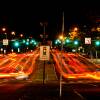This story first ran in GBH News’ politics newsletter. Click here to subscribe and get our rundown of the Massachusetts’ latest political happenings every Thursday morning straight to your inbox.
The topic of traffic safety is having a moment in Massachusetts.
Earlier this spring, the statewide advocacy group WalkMassachusetts reported that fatal pedestrian crashes spiked statewide from 2021 to 2022, with most of those fatalities coming in neighborhoods that are poorer and more diverse. (Boston saw the most with 12, followed by Worcester with 7 and Chicopee with 5.) Last week, Boston announced a new “safety surge” aimed, Mayor Michelle Wu said, at remaking the city’s roadways and allaying pervasive fears about dangerous traffic. In the wake of that announcement, the Boston Globe did a deep-dive story on strategies that could reduce casualties moving forward, from the speed humps featured in Boston’s plan to the red-light cameras that have been deployed in other states but aren’t used here.
As this conversation builds, though, it also features a striking blind spot. Right now, at least, there’s little interest in ramping up police enforcement of basic traffic laws to keep people from being hurt or killed. Stepped-up police enforcement wasn’t mentioned in the WalkMassachusetts report released back March. It’s not part of Boston’s “safety surge,” which is focused squarely on infrastructure. And the Globe’s discussion of enforcement revolved around the aforementioned automated cameras — which, it bears noting, were voted down by the Massachusetts Senate in 2020 and may never get the go-ahead on Beacon Hill.
This lacuna probably shouldn’t come as a surprise. In our current cultural moment, making ramped-up policing a part of any major policy push is a fraught proposition. If, hypothetically, Boston’s “safety surge” had included plans for increased police activity, calls for close scrutiny would likely have followed, given the racial disparities traffic stops tend to have. That same dynamic might also make cops in Boston and elsewhere leery of doing more: one recent survey found that, in 2021, officers across the country were less likely to stop vehicles for traffic violations than they were two years earlier, before calls for police reform and abolition swept across the country. What’s more, in Boston proper, any push to ramp up the BPD’s efforts could spark pushback from Boston’s police unions, which have tussled with the mayor for months as she tries to reform policing in the city.
Still, as fatalities rise and driving habits visibly deteriorate, there’s a strong case to be made for trying to boost enforcement anyway, as more systemically ambitious changes are pondered and rolled out by policymakers.
Earlier this week, I spent some time watching traffic at the intersection of North Beacon and Market streets, a busy intersection right by GBH’s offices. It was late morning, and the traffic was relatively light compared to what you see there at rush hour. Still, in the span of roughly 20 minutes, I watched six cars turn right on red, even though signs say it’s forbidden at this particular intersection. Seven other cars went straight through red lights. The last of these violations was especially egregious: a construction truck rumbled across a crosswalk a good two seconds after the light had changed, as a man pushing an elderly woman in a wheelchair waited to venture across.
Maybe, one day, a newly legal red-light camera will catch that truck’s driver as he casually flouts the most basic rules of the road. But right now, the best thing that could happen for the public at large would be for that driver to be stopped by a cop, and then forced to spend a few hundred dollars on a ticket and hiked insurance premiums. Unless the driver faces consequences, there’s no reason to think his behavior will change. And everyone he encounters as he traverses the roadways of Greater Boston is at risk.








